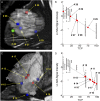Intraoperative assessment of tumor margins during glioma resection by desorption electrospray ionization-mass spectrometry
- PMID: 28607048
- PMCID: PMC5495278
- DOI: 10.1073/pnas.1706459114
Intraoperative assessment of tumor margins during glioma resection by desorption electrospray ionization-mass spectrometry
Abstract
Intraoperative desorption electrospray ionization-mass spectrometry (DESI-MS) is used to characterize tissue smears by comparison with a library of DESI mass spectra of pathologically determined tissue types. Measurements are performed in the operating room within 3 min. These mass spectra provide direct information on tumor infiltration into white or gray brain matter based on N-acetylaspartate (NAA) and on membrane-derived complex lipids. The mass spectra also indicate the isocitrate dehydrogenase mutation status of the tumor via detection of 2-hydroxyglutarate, currently assessed postoperatively on biopsied tissue using immunohistochemistry. Intraoperative DESI-MS measurements made at surgeon-defined positions enable assessment of relevant disease state of tissue within the tumor mass and examination of the resection cavity walls for residual tumor. Results for 73 biopsies from 10 surgical resection cases show that DESI-MS allows detection of glioma and estimation of high tumor cell percentage (TCP) at surgical margins with 93% sensitivity and 83% specificity. TCP measurements from NAA are corroborated by indirect measurements based on lipid profiles. Notably, high percentages (>50%) of unresected tumor were found in one-half of the margin biopsy smears, even in cases where postoperative MRI suggested gross total tumor resection. Unresected tumor causes recurrence and malignant progression, as observed within a year in one case examined in this study. These results corroborate the utility of DESI-MS in assessing surgical margins for maximal safe tumor resection. Intraoperative DESI-MS analysis of tissue smears, ex vivo, can be inserted into the current surgical workflow with no alterations. The data underscore the complexity of glioma infiltration.
Keywords: ambient ionization; glioma; lipids; neurological smears; tumor infiltration.
Conflict of interest statement
The authors declare no conflict of interest.
Figures




Similar articles
-
Intraoperative assessment of isocitrate dehydrogenase mutation status in human gliomas using desorption electrospray ionization-mass spectrometry.J Neurosurg. 2019 Jan 4;132(1):180-187. doi: 10.3171/2018.8.JNS181207. Print 2020 Jan 1. J Neurosurg. 2019. PMID: 30611146
-
Intraoperative Mass Spectrometry Platform for IDH Mutation Status Prediction, Glioma Diagnosis, and Estimation of Tumor Cell Infiltration.J Appl Lab Med. 2021 Jul 7;6(4):902-916. doi: 10.1093/jalm/jfaa233. J Appl Lab Med. 2021. PMID: 33523209 Free PMC article.
-
Lipid and metabolite profiles of human brain tumors by desorption electrospray ionization-MS.Proc Natl Acad Sci U S A. 2016 Feb 9;113(6):1486-91. doi: 10.1073/pnas.1523306113. Epub 2016 Jan 19. Proc Natl Acad Sci U S A. 2016. PMID: 26787885 Free PMC article.
-
A low-field intraoperative MRI system for glioma surgery: is it worthwhile?Neurosurg Clin N Am. 2005 Jan;16(1):135-41. doi: 10.1016/j.nec.2004.07.010. Neurosurg Clin N Am. 2005. PMID: 15561533 Review.
-
A new philosophy in surgery for diffuse low-grade glioma (DLGG): oncological and functional outcomes.Neurochirurgie. 2013 Feb;59(1):2-8. doi: 10.1016/j.neuchi.2012.11.001. Epub 2013 Feb 12. Neurochirurgie. 2013. PMID: 23410764 Review.
Cited by
-
High-throughput analysis of tissue microarrays using automated desorption electrospray ionization mass spectrometry.Sci Rep. 2022 Nov 7;12(1):18851. doi: 10.1038/s41598-022-22924-4. Sci Rep. 2022. PMID: 36344609 Free PMC article.
-
Advances in mass spectrometry imaging for spatial cancer metabolomics.Mass Spectrom Rev. 2024 Mar-Apr;43(2):235-268. doi: 10.1002/mas.21804. Epub 2022 Sep 6. Mass Spectrom Rev. 2024. PMID: 36065601 Free PMC article. Review.
-
Molecular characterization of human peripheral nerves using desorption electrospray ionization mass spectrometry imaging.J Anat. 2023 Nov;243(5):758-769. doi: 10.1111/joa.13909. Epub 2023 Jun 1. J Anat. 2023. PMID: 37264225 Free PMC article.
-
Advances in Imaging Mass Spectrometry for Biomedical and Clinical Research.Trends Analyt Chem. 2023 Dec;169:117344. doi: 10.1016/j.trac.2023.117344. Epub 2023 Oct 14. Trends Analyt Chem. 2023. PMID: 38045023 Free PMC article.
-
Artificial Intelligent-Enhanced Metabolite Profiling for Intraoperative IDH1 Genotyping in Glioma Using an Orthogonally Responsive SERS Probe.Adv Sci (Weinh). 2025 Jul;12(26):e2503360. doi: 10.1002/advs.202503360. Epub 2025 Apr 2. Adv Sci (Weinh). 2025. PMID: 40171868 Free PMC article.
References
-
- Orringer D, et al. Extent of resection in patients with glioblastoma: Limiting factors, perception of resectability, and effect on survival. J Neurosurg. 2012;117:851–859. - PubMed
-
- Hervey-Jumper SL, Berger MS. Maximizing safe resection of low- and high-grade glioma. J Neurooncol. 2016;130:269–282. - PubMed
-
- Louis DN, et al. The 2016 World Health Organization Classification of Tumors of the Central Nervous System: A summary. Acta Neuropathol. 2016;131:803–820. - PubMed
Publication types
MeSH terms
Grants and funding
LinkOut - more resources
Full Text Sources
Other Literature Sources
Medical

